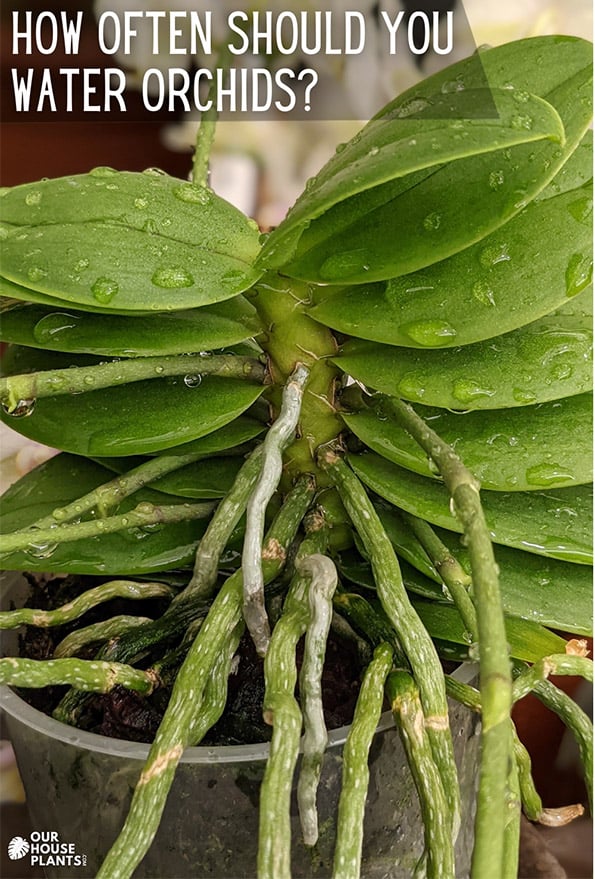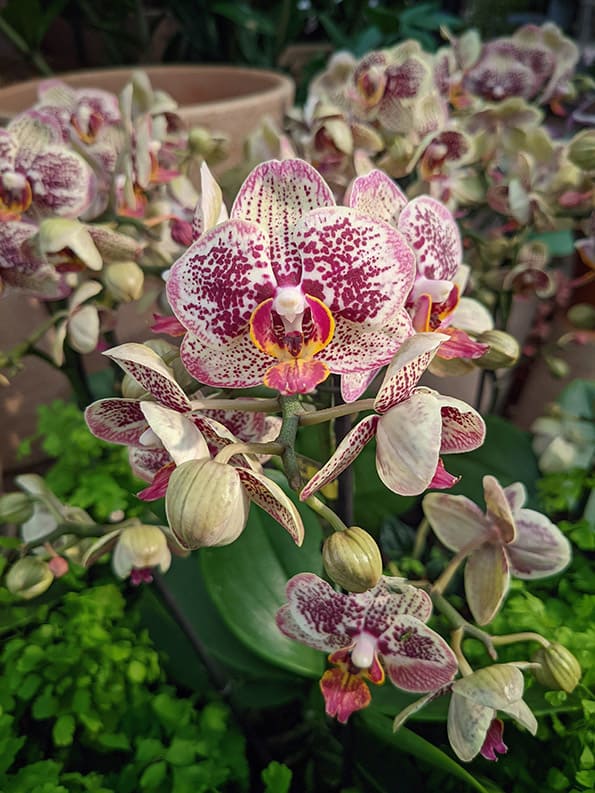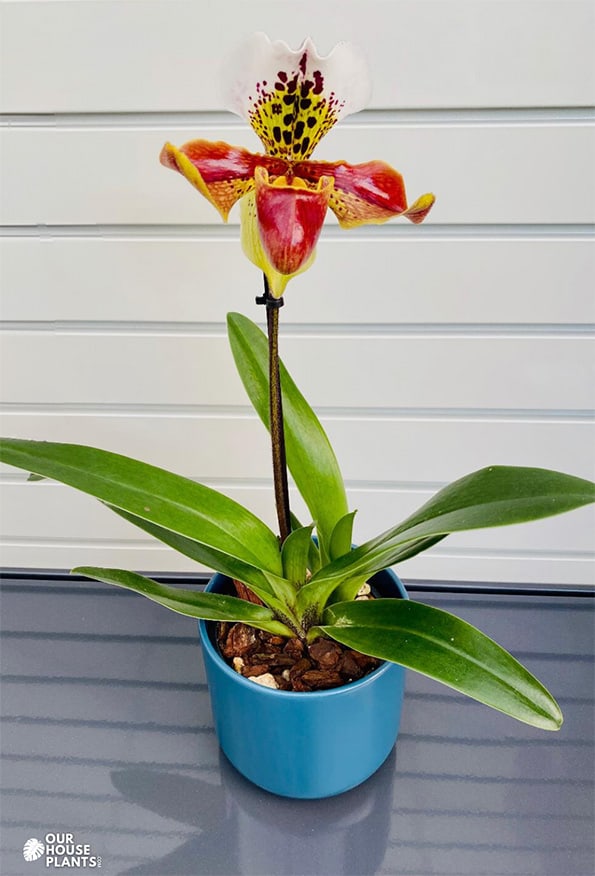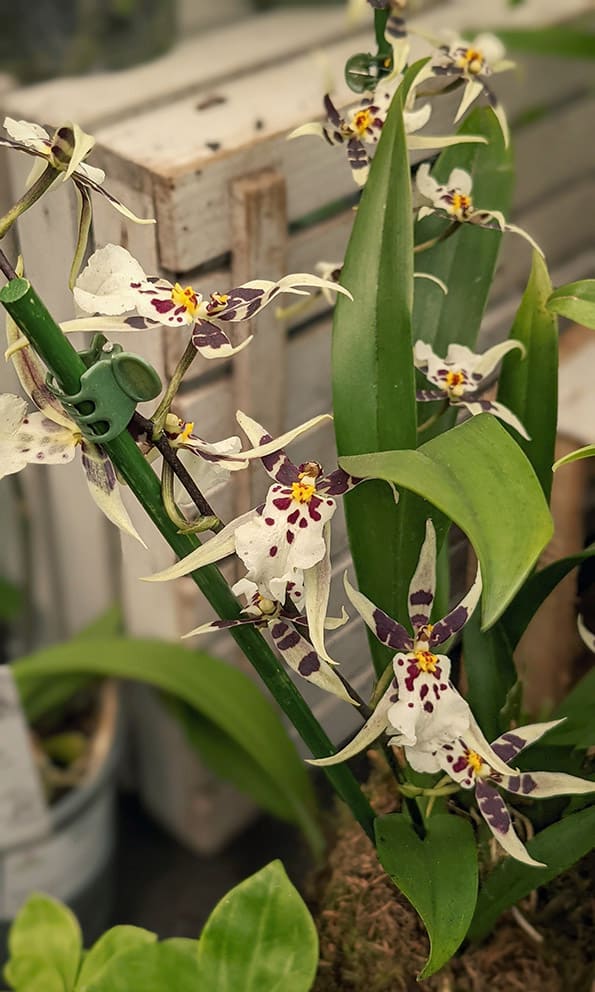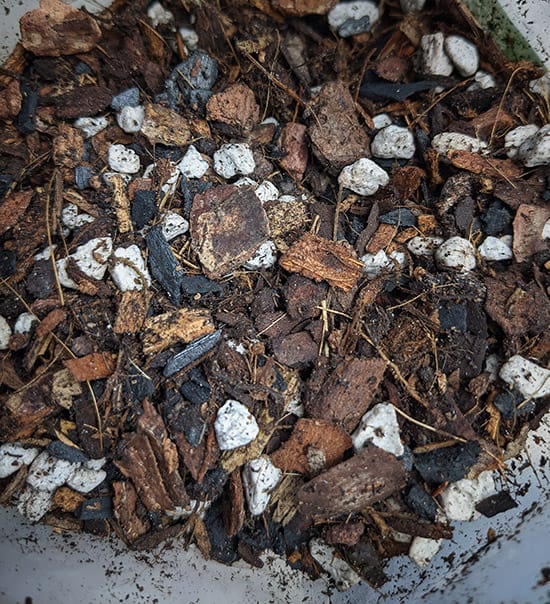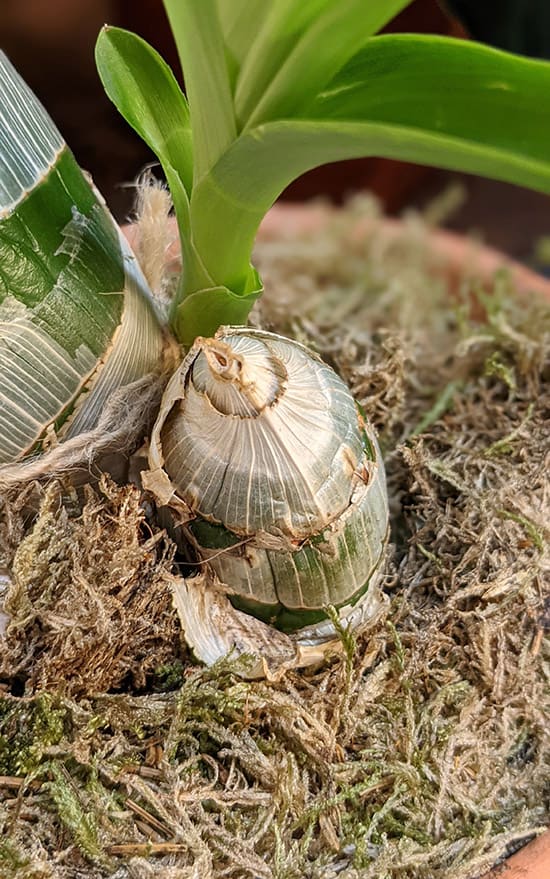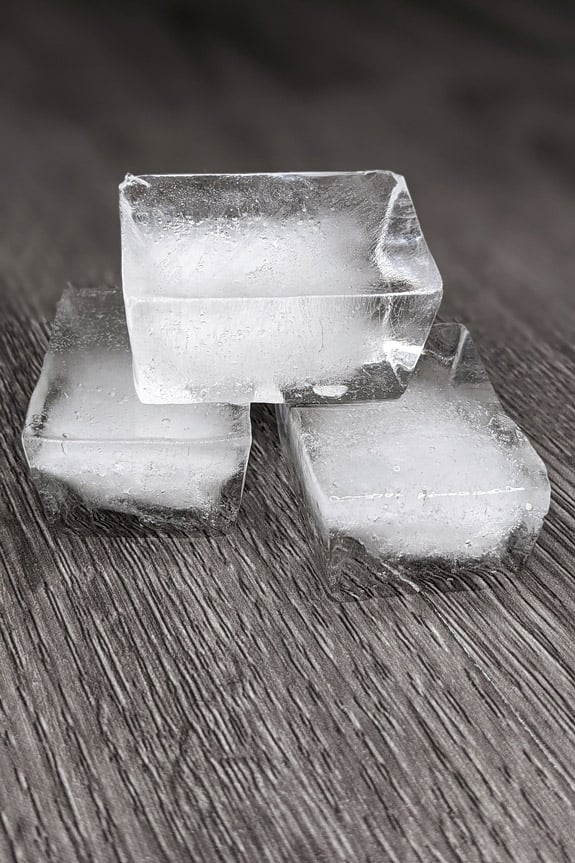The frequency of watering orchids depends on factors such as the type of orchid, the growing medium, environmental conditions, and the time of year. Anything from every few days or up to a month could be considered normal.
Orchids are unique plants with specific water requirements that differ from other houseplants. The goal is to find that sweet spot where your orchid thrives and that's not always easy to work out.
Many species of orchids are tropical plants and are use to water on their leaves and aerial roots. However, they don't like constant wetness, so you need to find the right balance.
This article covers the general guidelines and provides an interactive and easy quiz to complete. This will all give you an idea of the expected watering intervals needed for good orchid care (as well as a few other pointers along the way).

Hi, I'm Tom!
If you're like me and enjoy the challenge of growing houseplants and getting them to thrive, then Ourhouseplants can help. This website shares my knowledge and years of growing plants and provides (hopefully) helpful advice on properly caring for your indoor plant friends.
Orchids are a diverse family of plants, and different species or hybrids have distinct water requirements. Here is a quick summary of the more popular ones grown as houseplants and their watering needs.
Phalaenopsis (Moth Orchids) are one of the more common and well known orchids you can buy.
They're primarily epiphytic plants meaning in their natural habitat, these orchids are often found growing on trees or other surfaces, clinging to branches and rocks rather than rooting in soil.
The term "epiphytic" refers to plants that grow on other plants or structures, using them for support, while obtaining nutrients and water from the air, rain, and debris. However in our homes, Moth Orchids are quite happy in a clear plastic pot.
Phalaenopsis orchids have aerial roots that play a crucial role in their epiphytic nature and understanding their watering needs.
These roots are adapted to absorb moisture and nutrients from the surrounding environment. They're coated with a spongy tissue called velamen, which helps them absorb water efficiently.
Typically Phalaenopsis prefers to dry out slightly between waterings. So based on ideal environmental conditions and good care being provided you will be looking to water them approximately every 7-10 days.
This would also be true for the Slipper Orchid (Paphiopedilum). But as you will see later, this can differ widely depending on other factors.
A Slipper Orchid (Paphiopedilum) can be grown in a potting media of bark chips, similar to a Moth Orchid, it also has comparable watering needs. It doesn't need a clear pot though and is perfectly happy in a decorative pot like this.
Terrestrial Orchids are in general much less common as houseplants, but the Jewel Orchid (Ludisia discolor) is incredibly well known and sought after.
Terrestrial orchids grow directly in the ground, with their roots embedded in soil. This means they have a more conventional root system that prefers a well-draining but moisture-retaining growing medium.
They often like their soil to be consistently moist but not waterlogged during the growing seasons, and over winter they prefer to dry out a little more between waterings, this is similar to many other houseplants.
The Vuylstekeara Orchid (Cambria Orchid), Cymbidium, Dendrobium, and Oncidium Orchids are less popular plants, but you will still see them in many garden centers and even supermarkets. They often have very attractive long lasting flowers and some are even scented.
In warm summers, Oncidium orchids will need a good soak every week or so, just make sure you let water drain away afterwards as they don't like sitting in standing water.
Like the Moth and Slipper Orchid they tend to be epiphytic, clinging to trees in their native habitats, while others are lithophytic and are adapted to growing on rocks.
Many of these orchids feature pseudobulbs, swollen stems that serve as storage organs for water and nutrients. These pseudobulbs contribute to the orchid's resilience in challenging conditions.
However they're generally more thirsty plants and the white string like roots dry out faster, especially during active growth periods. They may need more frequent watering, possibly every 5-7 days in hot and bright locations.
Tell me about the environmental conditions your Orchid is growing in by answering the four questions below. I can then give you a rough estimate of how often you can expect to water your plant.
This is a rough guide based on some assumptions which I detail below.
If you're not sure how to answer any of the questions, I will go into these factors in more detail further into the post. Once you've read this, come back to answer these questions.
What type of light is your Orchid Plant growing in?
How would you describe the daytime room temperature?
What time of year is it for you?
What type of potting medium is your Orchid growing in?
Results will show here once you've answered all four questions above.
You can reset the quiz with the button above if you want to run it again for different Orchid Plants in your collection.
The results are based on a few assumptions.
Orchids generally have aerial roots adapted to absorb moisture and nutrients from the air. The growing medium must provide excellent aeration to ensure oxygen reaches these roots.
As it directly impacts the orchid's health, growth, and overall well-being the type of growing medium used for orchids is crucial. However it can drastically affect the watering needs and requirements compared to other houseplants.
As long as excess water can escape from drainage holes at the base of the container, a well-draining medium like this prevents water from pooling around the roots, reducing the risk of root rot.
Orchids are often potted in a well-draining orchid bark mix, this ensures water drains freely through the pot. Which in most cases is exactly what you want.
While orchids need good drainage, they also require a growing medium that retains some moisture. Orchids typically go through cycles of wet and dry conditions in their natural habitats. The growing medium should strike a balance, allowing the orchid to access water while preventing waterlogging.
If the mix is too free draining, it will dry out super fast and you will need to water more frequently. Consider using a mix with a little more organic material or even some sphagnum moss.
For orchids potted in sphagnum moss, water when the top layer feels dry. Sphagnum moss retains moisture well, so be cautious not to overwater.
You could even use sphagnum moss exclusively. This will create an interesting aesthetic, but it can retain water several times its weight so you need to be careful that it's not too compacted or holding too much water for your orchid.
The environmental conditions and seasonal variations affect how frequently you will need to water your orchids. For example, you will get different results if you come back every three months and redo my quiz above.
This means fixed watering schedules won't work and you have to be prepared to change things up when required. The major factors here are:
How do I know if my Orchid needs watering?
Here are some cues to help you determine if your orchid needs watering
Check the Growing Medium: Orchids are often potted in a well-draining mix, such as bark, sphagnum moss, or a specialized orchid mix. Insert your finger into the growing medium, and if it feels dry to the touch, it may be time to water.
Weight of the Pot: Lift the pot and gauge its weight. A dry pot is lighter than a moist one. If the pot feels light, it indicates that the growing medium has dried out, and your orchid may need watering.
Appearance of Pseudobulbs or Canes: For orchid varieties with pseudobulbs or canes, observe their appearance. Pseudobulbs or canes that look plump and well-hydrated indicate that the orchid has sufficient moisture. Shriveling or wrinkling pseudobulbs may suggest that the orchid is dehydrated and needs water.
Roots: Orchids often have aerial roots adapted to absorb moisture from the air. Healthy aerial roots are typically silver or green. If they appear dry, or silvery, it could indicate that the orchid needs watering.
Aerial roots outside of the container will dry fast and may look silvery even when those are within the container are still green.
You can see this in the demonstration below. To see how the roots change in the presence of water, use the slider in the above photo to move or tap back and forwards.
Orchid roots before and after watering in a typical clear moth orchid pot.
Is it better to Bottom Water or Top Water Orchids?
There are advantages and disadvantages to each method of watering. However, if the potting mix is very free draining, bottom watering will unlikely allow water to move up to the surface easily. So top watering and "dunking" them into a bowl of water for a few minutes is usually the better approach.
If you want to explore this in more detail, I have an article you might like. Is it better to water plants from the bottom or the top?
What type of water should I use?
The good news is that you can use water from several sources. Some can be problematic though. I'll quickly cover this now.
Filtered or Distilled Water is free from minerals and impurities that can accumulate in the growing medium over time. It helps prevent salt buildup and mineral deposits on the roots. Perfect for owners who live in hard water areas.
Temperature Considerations - Using room temperature or slightly tepid water can prevent shocking the orchid's roots. Avoid using extremely cold or hot water, which may stress the plant.
Rainwater is naturally soft and contains some beneficial elements. It lacks minerals found in tap water and is ideal for most Orchids because they often thrive in soft water conditions.
Tap water is readily available and convenient. It often contains minerals that can potentially benefit orchids. But tap water may have high levels of chlorine or fluoride and it could be classed as "hard" with higher levels of lime or calcium that some epiphytic plants dislike.
These minerals can accumulate in the growing medium, leading to potential issues. So if using tap water, it's advisable to periodically flush the growing medium to minimize mineral buildup.
What does an overwatered Orchid look like?
Overwatering can be an issue with any houseplant, including orchids. These are some signs to watch for.
Yellowing Leaves: One of the first signs of overwatering is yellowing leaves. If the leaves of your orchid start turning yellow, especially at the base of the plant, it could indicate that the roots are suffocating due to excessive moisture.
Soft and Mushy Roots: Gently remove the orchid from its pot and inspect the roots. Overwatering can lead to root rot, causing the roots to become soft, mushy, and discolored. Healthy orchid roots should be firm, white or green.
Wrinkled Pseudobulbs or Canes: Overwatering can cause these structures to become waterlogged and appear wrinkled or shriveled instead of plump and turgid.
Algae Growth: Excessive moisture in the growing medium can create conditions for algae to grow. If you notice green algae on the surface of the medium, it may indicate that the orchid is receiving too much water.
Rot: If the crown, roots or any part of the plant appears dark, discolored, or mushy, it could be a sign of rot, often caused by overwatering. If this is happening you should head over to my how to fix root rot guide.
How to water orchid with Ice Cubes?
Watering orchids with ice cubes is a popular method of watering as it provides a controlled and gradual release of water.
It's really not an essential way to water any plant, including orchids and here's my full explanation as to why. However it's pretty harmless if you want to give it a try. Read on for a few tips.
The ice cube method of watering involves placing a few cubes on the surface of the potting medium and waiting for it to melt. It's pretty simple and it does work for many different types of orchids, especially those in smaller pots.
To get started grab a few ice cubes. The number of cubes depends on the size of your orchid and the specific care requirements. Generally, start with 2-3 ice cubes for small to medium-sized orchids and adjust as needed.
Place the ice cubes on the surface of the growing medium. Position them evenly around the pot to ensure gradual melting and water distribution.
Let the ice cubes melt naturally. As they melt, the water will be released slowly, mimicking a gradual watering process.
Finally, place a tray or saucer under the orchid to catch any water runoff. This also allows you to gauge how much water the orchid is receiving. If there's excessive runoff, you may be using too many ice cubes.
